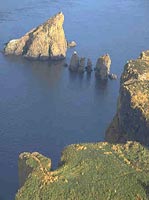The Micmac Tribe
The tribal territory included all of what is now Nova Scotia and Prince Edward Island, the Gaspe Peninsula of Quebec, the north shore of New Brunswick and inland to the Saint John River watershed, eastern Maine, and part of Newfoundland, including the islands in the Gulf of Saint Lawrence as well as St. Pierre and Miquelon. The Micmacs' neighbors recognized their territory and rarely violated its borders. Micmac people thought of their homeland as containing seven districts: Kespukwitk, Sikepne'katik, Eski'kewaq, Unama'kik, Piktuk aqq Epekwitk, Sikniktewaq, and Kespe'kewaq. A keptan orsaqmaw (district chief) presided in each jurisdiction, doubling as local ruler and delegate to the Grand Council Sante' Mawiomi. The Grand Council was the governing body of the nation and was led by several officers, including a kji'saqmaw(grand chief), a putus (treaty holder and counselor), and a kji'keptan (grand captain, advisor on political affairs). The Sante Mawiomi determined where families might hunt, fish, and set up their wumitki (camp). More importantly, the Grand Council managed relations with other aboriginal nations. The Micmacs were members of the Wabanaki Confederacy, a loose coalition that included the Maliseets, the Pasamaquoddy, the Penobscots, and the Eastern and Western Abenakis of present-day Maine, New Hampshire, and Vermont. At its peak, this confederacy influenced tribal life from the Gaspe Peninsula to northern New England. The Micmacs' first contact with Europeans did not surprise them or alter their worldview. A legend in which one of their spiritual beings traveled across the Atlantic to "discover" Europe taught that blue-eyed people would arrive from the east to disrupt their lives. Micmac people also knew the story of a woman who had a vision of an island floating toward their lands; the island was decked out with tall trees on which were living beings. Thus the Micmacs were not startled by the appearance of early explorers in sailing ships. Instead, they greeted the newcomers, set up a brisk trade with them, and looked forward to incorporating the strangers' new technologies into their own culture. The Micmac language is part of the Algonquian language family, and its ancestral language is Proto-Algonquian. Early forms of communication among the Micmacs included an elaborate system of runners who went from village to village relaying messages about recent or future events, treaties entered into, and even calls to war. The earliest written language was a hieroglyphics on birchbark or animal hides. 
But there is also another site held sacred to the Micmac that holds a similiar Glastonberry Grove-like quality. In Bedford, Nova Scotia, Canada, is a circle of birch trees right next to a feldspar stone marker. Inside the circle of trees is a deposit of upright stones. Read More Micmac Poems
Eerily familiar to the scene with Laura and Bob in FWWM. The Legend of Gooscap's Door Prophetic Dreams Micmac Legends
A crossing through the Micmac gateway. Robbery And Murder Revenged Fascinating Bob and Mike-like early partnership and crossing through the Micmac gateway. Micmac Creation Story Mysteries of the Templars In The Legends of Glooscap Some theories of how the Micmac god is based on the Templars - the keepers of the Holy Grail. |